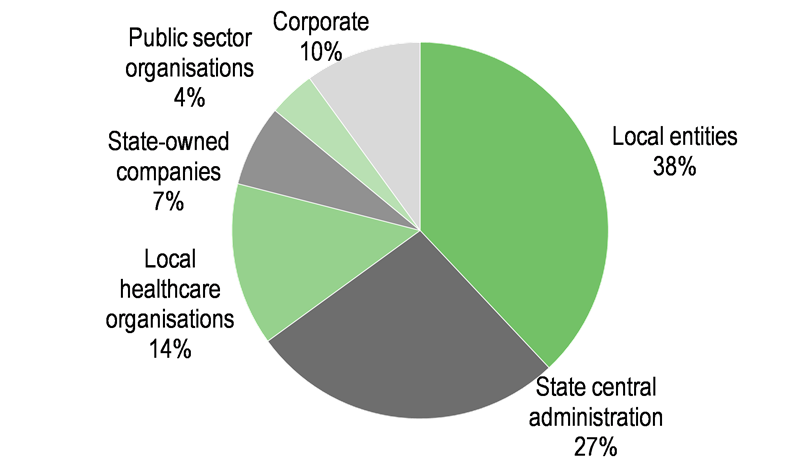Market background and outlook
In this section we provide background on the Italian receivables factoring, salary and pension loan markets and, briefly, the pawnbroking market given the recent initial step Banca Sistema has made into this market. We also consider the outlook in these markets.
Receivables factoring in Italy
Exhibit 8 puts the overall Italian factoring market in a European context, comparing it with some of other the larger markets. Italy ranks fourth in size; its 11.6% penetration (relative to GDP) is above the 10% European average but noticeably below the near-15% level seen in the UK. Banca Sistema cites Italian treasury (MEF) data indicating public sector factoring penetration at 7% of government spending. Exhibit 9 highlights the relatively long public sector payment times that characterise the Italian market supporting the suggestion that there should be good scope to increase penetration from the current level. Payment times in business-to-business transactions are shorter but at 80 days are also the longest in Europe.
Exhibit 8: EU factoring penetration & market size 2015
|
Exhibit 9: Average public sector payment times 2015
|

|

|
Source: EU Federation for Factoring and Comml. Finance Industry
|
Source: Intrum Justitia, European payment report 2016
|
Exhibit 8: EU factoring penetration & market size 2015
|

|
Source: EU Federation for Factoring and Comml. Finance Industry
|
Exhibit 9: Average public sector payment times 2015
|

|
Source: Intrum Justitia, European payment report 2016
|
A study by CRIBIS published in November 2016 underlined the extended payment times that prevail in the Italian public sector. This showed that only 22.3% of public administration entities paid on time, compared with 35.9% for private sector companies. While the number of good payers has increased from 11.5%, since 2010 the number of those paying later than 30 days after the due date also increased (from 20% to 25.3%).
The Italian health system is particularly prone to late payment and CRIBIS indicates that 61% of health system entities pay more than 30 days late. The latest industry figures from Assobiomedica show an average of 150 days. As Exhibit 10 shows, there has been a marked downtrend in recent years, perhaps reflecting a number of measures to help contain late payment and the cost of late payment interest. However, the average time to payment remains long, the figures may be influenced by the exclusion of factored invoices and the average also hides the still very wide regional variation.
Exhibit 10: Italian health system average payment times
|
Exhibit 11: Italian health system DSO by region
|

|

|
Source: Assobiomedica Note: 2017 average to February
|
Source: Assobiomedica. Note: DSO = days sales outstanding
|
Exhibit 10: Italian health system average payment times
|

|
Source: Assobiomedica Note: 2017 average to February
|
Exhibit 11: Italian health system DSO by region
|

|
Source: Assobiomedica. Note: DSO = days sales outstanding
|
As we show in Exhibit 11 payment times range between 76 days and 506, suggesting there are still substantial opportunities for factoring companies to assist clients in managing receivables and cash flows. Weighting these regional figures for payment times by BST’s outstanding receivables gives a figure of 189 days: 32% above the national average. This can be compared with the range of funding periods (241 to 461 days) BST assumed when pricing receivables portfolios during FY16, suggesting prudent criteria are applied, even allowing for some adverse selection on the part of sellers.
The level of factoring outstanding in the Italian market (private and public sector) grew at a compound annual rate of 6% in the 10 years to 2016. Growth fluctuated significantly during the period, accelerating following the financial crisis as the availability of credit from mainstream lenders was constrained, but then reversing following the euro-area crisis in 2011-12. Modest growth has resumed subsequently. For the first three months of 2017 the level of factoring outstanding has been above the prior year period (+2.7% at end March), while cumulative turnover was 19% ahead for the first quarter.
Exhibit 12: Growth in factoring outstanding in the Italian market
|

|
|
|
Exhibit 13 shows the leading providers of factoring in Italy. The market appears quite concentrated with the top five companies accounting for a share of over 70%. However, calculating the Herfindahl-Hirschman index gives a figure of 1,266, which would not generally be seen as markedly concentrated.
Exhibit 13: Leading providers of factoring in Italy (as at end December 2016)
|
Outstanding (€m) |
Market share (%) |
Cumulative mkt share (%) |
|
Parent |
Specialisation |
Mediocredito Italiano |
13,898 |
22.8 |
22.8 |
|
Banca Intesa |
|
UniCredit Factoring |
11,681 |
19.1 |
41.9 |
|
UniCredit |
|
IFITALIA |
8,853 |
14.5 |
56.4 |
|
Intesa Sanpaolo |
|
Banca IFIS |
5,911 |
9.7 |
66.1 |
|
Independent |
Emphasis on SME/retail DRL |
UBI Factor |
3,052 |
5.0 |
71.1 |
|
UBI Banca |
|
Factorit |
2,771 |
4.5 |
75.7 |
|
BNP Paribas |
|
SACE FCT |
2,059 |
3.4 |
79.0 |
|
CDP (SACE) |
|
Banca Farmafactoring |
1,794 |
2.9 |
82.0 |
|
Independent |
Emphasis on health service recbls |
MPS L&F |
1,749 |
2.9 |
84.9 |
|
Banca MPS |
|
Creditech |
1,134 |
1.9 |
86.7 |
|
Mediobanca |
|
Banca Sistema |
1,005 |
1.6 |
88.4 |
|
Independent |
Emphasis on public administration |
Emil-Ro Factor |
976 |
1.6 |
90.0 |
|
BPER Banca |
|
Credemfactor |
641 |
1.1 |
91.0 |
|
Credem |
|
BCC Factoring |
620 |
1.0 |
92.0 |
|
Iccrea Banca (Credito Cooperativo) |
|
Fidis |
598 |
1.0 |
93.0 |
|
FCA (Fiat Chrysler) |
Captive finance provider |
Source: Assifact, Edison Investment Research. Note: Following acquisitions IFIS includes GE Capital and Sistema, Beta Stepstone.
Banca Sistema ranks eleventh in this table and is one of three independents shown. The top three players are parts of large banks and in some instances the emphasis may be more on providing receivables management and credit guarantees to existing customers rather than financing. Of the independents, Banca IFIS is the largest player followed by Banca Farmafactoring (recently completed its IPO) which is more comparable with Banca Sistema given its focus on health system receivables.
Salary and pension-backed loans, a low risk market
As noted earlier these are loans backed by salaries or pensions with additional security provided by compulsory insurance. Levels of growth had been strong prior to the financial crisis, but then stalled before resuming more modest growth (Exhibit 14). The flow of new loans continued to grow last year (+17%), but the level of loans outstanding was marginally lower as the rate of churn increased from 26% to 31%. The analysis of loans made in 2012-15 shows that state employees and pensions have accounted for a large proportion of the total, again tending to lower the credit risk exposure. Nevertheless, the risk weighting applied to these loans is 75% so expansion in this area is relatively capital intensive. Industry representations to reduce this weighting might improve the level of capital absorbed in Banca Sistema’s planned expansion here in due course. In the meantime, securitisation and sale are likely to moderate the capital requirement.
Exhibit 14: Italian salary-backed loans evolution
|
Exhibit 15: Italian salary-backed loans flow analysis
|

|

|
Source: IBL Banca Group, Assofin
|
Source: IBL Banca Group, Assofin
|
Exhibit 14: Italian salary-backed loans evolution
|

|
Source: IBL Banca Group, Assofin
|
Exhibit 15: Italian salary-backed loans flow analysis
|

|
Source: IBL Banca Group, Assofin
|
Pawnbroking market
The pawnbroking market is a niche area with Banca Sistema citing Bank of Italy figures showing turnover of €800m per annum. The main players in this market are commercial banks and independent broker networks. The ticket size is typically small with 30,000 loans issued per month. Banca Sistema intends to focus purely on gold backed loans initially and these account for 60% of turnover with jewellery and diamonds the next largest category at 20% followed by 12% for watches. Between 92% and 95% of pledges are redeemed with the remainder sold at auction. Loans are generally short duration with Banca Sistema offering three-, six- and 12-month terms; the maximum period for which a loan can be renewed is three years and the ministry of finance (MEF) sets maximum interest rates as required by Italian usury law.
Outlook
The macroeconomic and political background in Italy remains uncertain with periodic concerns over eurozone health (generally positive for factoring volumes as international companies seek to reduce exposure), resolution of the Italian banking system legacy of bad debts and Brexit implications among the possible threats to the economy. Nevertheless, forecasts such as those from the OECD and the European Commission point to continued recovery from recession with GDP growth of around 1% expected for this year and next while unemployment is expected to fall slightly (but remain above 11%).
For the markets that Banca Sistema operates in this background would broadly represent a continuation of current conditions. Government consumption is only expected to increase marginally but the main opportunity for the bank in public sector receivables factoring is greater penetration (as mentioned earlier this is estimated to be only 7%) and an increase in market share (currently less than 2% of the overall factoring market). For Banca Sistema the resumption of stronger factoring turnover growth in the first quarter is encouraging and, while there are likely to be fluctuations in the level of turnover by quarter, we look for good growth in factoring receivables outstanding against a background of moderate market growth. Periods of increased concern over the economy or political situation while worrying in a general sense could present increased opportunities for Banca Sistema to purchase receivables portfolios from international companies wishing to lower their exposure.
For the salary and pension-backed loan business modest overall growth in the market seems a reasonable assumption, but for Banca Sistema greater focus on and capital commitment to this area is likely to be the key driver of growth.
In pawnbroking the prospects for Banca Sistema’s operation will largely depend on the successful establishment of the initial branches, including the recruitment of key staff. The level of gold price (on a broadly upward trend since late 2013) can have a positive or negative influence on the volume of business, level of loans that can be granted and any auction income.

































